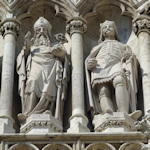
When Emperor Franz Joseph survived an assassination attempt in 1853, his brother decided a quick prayer of thanks wouldn’t suffice as a suitable expression of gratitude. So he set up an appeal and had the huge Votivkirche church built instead.
- Grand neogothic church completed in 1879
- Highlights include the painted ceiling arches and stained glass windows
- Only missing the historical gravitas of many old town colleagues
- Book a themed guided tour* of Vienna
- See also:
A church of thanks
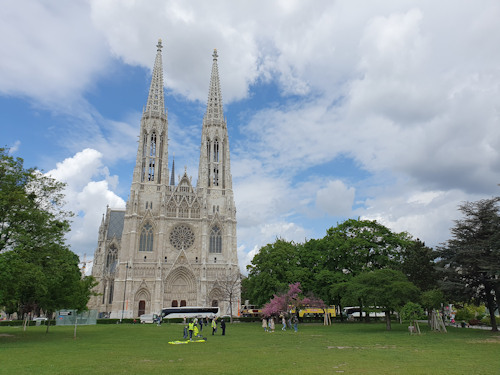
(The Votivkirche viewed from Schottentor)
On February 18th, 1853, a young Emperor Franz Joseph peered over the wall of the city fortifications, perhaps wondering if the land below really should be opened up for construction (as happened shortly after).
The next few seconds were to have far-reaching consequences for Vienna’s cityscape.
Hungarian nationalist, János Libényi, used the moment to launch an assassination attempt, striking at the emperor from behind with a knife.
The assassin’s first thrust left only a minor wound, and he never got the chance for a second: Franz Joseph’s adjutant tackled the assailant to the ground and held him there with the help of a passing butcher.
Libényi’s reward was a place on the gallows. The butcher’s was a knighthood.
Nobody knows how world history might have changed had Libényi succeeded. But we do know there’d be no Votivkirche church.
After the event, Franz Joseph’s brother, Archduke Maximilian, launched a fundraising initiative to build a “votive church” as thanks for the survival of the monarch.
The event also gave us new music from Johann Strauss II, never one to miss out on the chance to make a marketing opportunity out of current events: the Rettungs-Jubel-Marsch (English: Rescue-Jubilation march) premiered just over two weeks after the incident.
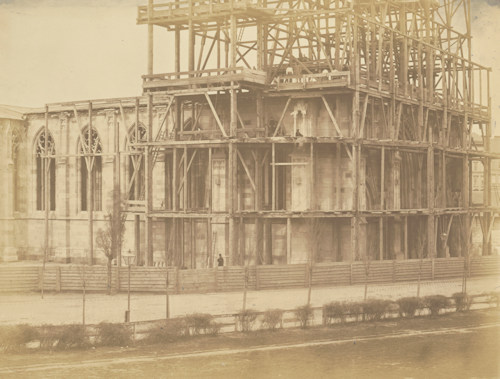
(Construction of the Votivkirche, 1859, photographed by the k. k. Hof- und Staatsdruckerei Wien; Wien Museum Inv.-Nr. 23845/2; excerpt reproduced with permission under the terms of the CC0 licence)
It took more than 20 years (until 1879) to build the Votivkirche to a neogothic design by Heinrich Ferstel. The lengthy construction period saw one cartoonist of the time use the following caption on the day of the church’s formal opening (my translation):
I was just a kid at the laying of the foundation stone for the Votivkirche. By the time it was completed I was already a grandfather.
That contract launched young Ferstel’s career, though, and he went on to build such landmarks as the MAK museum and what is now Palais Ferstel (home to the wonderful Café Central).
The Votivkirche did not fare quite so well as its architect.
The building stood as a giant symbol of the empire: various lands and cultures united under one (literal and metaphorical) roof.
However, the second half of the 19th century saw the idea of total Austrian hegemony over a diverse empire lose its appeal: a change of opinion that contributed to the birth of Austria-Hungary.
As a result, the symbolic attraction of the Votivkirche undoubtedly weakened, too.
Although a remarkable and important example of neogothic church architecture, the popularity of historicism in building design also began to wane as the century continued.
Today, this huge church serves a small parish and provides an important home for disparate international Christian communities, almost as if returning to its original scope.
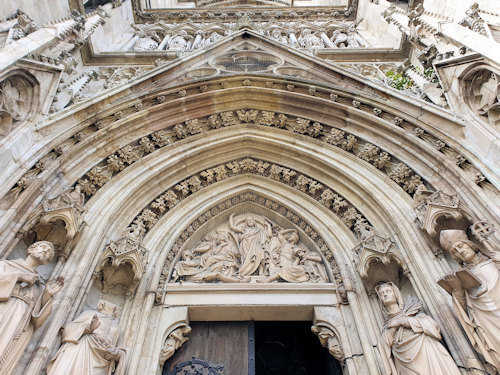
(East-side portal into the Votivkirche)
But what can you expect from a look around the building?
The church has the feel of a medieval English cathedral, all tall spires (almost 100m high), wide spaces inside, and stained glass windows.
But there’s the touch of an unloved stepchild about it. As if the Viennese and visitors know it’s there but have never really embraced it as part of the famous historical infrastructure of the city.
Which is all a shame, as I’m quite fond of the place. I see it less as an unloved stepchild and more as a careworn old servant quietly going about their business, taking care of communities that are far from home.
Despite the neogothic design with lovely vaulted and decorated ceilings, the building cannot hide its youth and origins. For example, the coats of arms of various imperial territories line the walls inside, reminding us that the church’s construction had something other than a purely ecclesiastical purpose.
You find yourself almost regretting they didn’t build it half the size to save themselves (and the current church authorities) considerable time and expense without losing any of the value.
The Votivkirche is free to walk around, of course, but also has a small museum that does require an entrance ticket. The displays include liturgical items, flags, and designs for the stained glass windows.
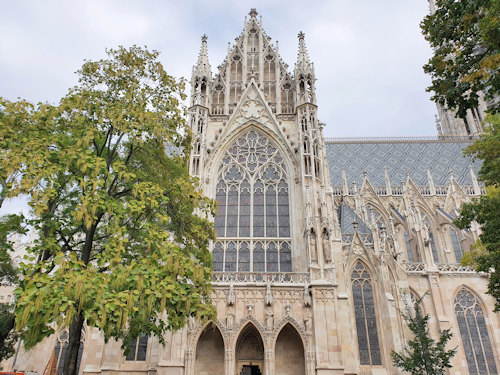
(South-side view and entrance)
How to get to the Votivkirche
Even the location seems to mirror the church’s fate: somewhere in between; neither entirely central nor not central.
The Votivkirche stands alone in a small park just outside the old town and close to the few remains of city fortifications that once witnessed that foiled assassination attempt.
Subway: a short walk from the large Schottentor transport hub that sits on the U2 subway line. A view of the church from the station even features in the movie, Before Sunrise.
The church also (almost) makes an appearance in the biographical drama The Woman in Gold. A lot of the action takes place on Franziskanerplatz and Frankgasse, which are the Votivkirche’s immediate neighbours. So you catch brief glimpses of the stone walls in the background to shots.
Tram: three trams pass through Schottentor (1, 71, D) and several start/end their line there (37, 38, 40, 41, 42, 43, 44). If you travel to Schottentor on any of the latter, get out one stop early for the Votivkirche.
Address: Rooseveltplatz, 1090 Vienna | Website